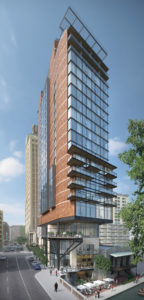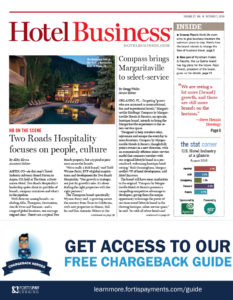SAN ANTONIO—The San Antonio market’s stable, diverse economy and tourist attractions have enticed both investors and tourists, yet there are still challenges awaiting the city’s hoteliers.
“San Antonio is considered one of the more stable hotel markets in the region,” said Jeffrey Binford, director of CBRE Hotels Group, a specialized advisory group within CBRE. “The stability is attributed to San Antonio’s types of visitors and the stable, diversified economies.”
Properties in the city are forecast to see a RevPAR increase of 5.5% by year-end 2018, according to CBRE Hotels’ latest “Hotel Horizons” report. An estimated increase in occupancy of 0.9% and a 4.6% gain in ADR are what’s driving the year-end increase in RevPAR, according to the data. RevPAR nationally is expected to jump by 3.1% in 2018.
“The current market in San Antonio has been strong comparable to the last couple of years,” said Pratik Patel, CEO of REM Hospitality, a locally based property management company. “Being in the lodging industry in San Antonio for the last 20-plus years, developers and operators understand that the markets here are very slow to react to positive or negative universal trends throughout the nation. The last five years, we have been recovering from an oversupply and have seen steady growth without the presence of strong supply growth.”
Total room supply in the city is 47,126, according to CBRE’s report.
RevPAR growth in the upper-priced segment of San Antonio is forecast to attain a 4.7% gain in ADR and an increase of 1.6% in occupancy. Lower-priced hotels in the Texas city are projected to experience an ADR growth rate of 4.1% and witness a gain of 0.4% in occupancy.
“In 2018, upper-priced hotels are expected to see a 6.4% increase in RevPAR compared to lower-priced hotels’ increase of 4.5%, which are solid increases for both,” Binford said. “For both upper- and lower-priced hotels, the RevPAR increases are attributed to ADR increases. Upper-priced hotels are concentrated in the central business district, and due to relatively high occupancy in this submarket, these properties are successful in driving their room rates.”
As of Q2 2018, there are 41 properties with 4,644 rooms in the market’s supply pipeline. The majority of the projects are in the lower-priced segment of the market, CBRE’s data revealed.
“Due to San Antonio’s modest increases in supply, it is the exception rather than the norm for significant hotels being built in the area,” he said. “They’re much more difficult from all respects—obtaining developable land at reasonable prices, planning, financing and operating. It is, however, exciting to see new concepts being introduced, both branded and independent.”
For example, in a joint development between Crockett Urban Ventures and Merritt Development, the 195-room Canopy by Hilton San Antonio River Walk, which will be managed by White Lodging Services Corp., is under construction.
“These hotels should serve the market well and entice more ‘lifestyle’ travelers to San Antonio,” Binford said.
As far as notable property openings in the city, more recently, in collaboration with New Era IV LLC and Premier Property Management, Choice Hotels International Inc. opened the WoodSpring Suites San Antonio Stone Oak. The hotel represents the fourth WoodSpring Suites property to open in the city. In May, with 95 rooms in total, Tru by Hilton San Antonio Downtown Riverwalk, owned and managed by Baywood Hotels, opened. With 26 guestrooms and 30 suites, the SureStay Hotel by Best Western San Antonio Northeast opened back in January.
“In recent years, other markets have attracted significant hotel developments—Austin, Dallas, Fort Worth and Houston have all been very active in their hotel developments,” Binford said. “San Antonio, due to its diverse and stable economy, has only seen moderate increases in the supply of new hotel rooms. Many of the other hotel markets around the state can be likened to a ‘flash in the pan,’ chasing new opportunities as they arise, and slowly fading. San Antonio has historically seen slow, steady increases in both supply and demand. For the most part, San Antonio has been well-balanced in that regard.”
For investors, the city’s hotel market is enticing. “San Antonio has always been attractive to investors due to the fact that our business here does not react like other markets to recessions and strong growth,” Patel said. “The lodging industry’s RevPAR and profitability curves are not as intense as other cities in Texas, like Houston or Dallas.”
The San Antonio market has been growing consistently over the years, and this market growth has been pairing fairly well with the city’s thriving tourism industry.
“San Antonio’s diverse economy provides ample market segments to entice travelers to your hotel,” Binford said. “Guests love many aspects of San Antonio—not only the rich Hispanic culture and history and the lure of the water along the River Walk, but San Antonio has all the tourist attractions for leisure vacations.”
The city is known for its numerous tourist attractions, including the Alamo, the River Walk, the San Antonio Missions World Heritage Sites, Six Flags Fiesta Texas, SeaWorld San Antonio and more. “The city is also an attractive convention destination, especially during mild fall and winter seasons,” said Paul Vaughn, SVP of Source Strategies, a locally based hotel consultancy firm. “Developers are attracted when they see a reasonably safe bet.”
Still, the city’s hotel market is facing obstacles of its own.
Tourism marketing is one of the city’s top challenges. “There has been an uptick since 2015, but much of the hotel occupancy tax revenue is used for purposes other than tourism promotion,” Vaughn said. To alleviate this issue, local hoteliers are proposing an added 1.25% hotel fee on top of the city’s 16.75% occupancy tax to generate additional revenues. These assessments would then be invested into a city tourism public improvement district (TPID), a mechanism for funding tourism promotion activities.
“Hopefully, it will be spent wisely to promote San Antonio as a destination,” he said. “This is happening as the Texas Legislature has already voted to sharply cut tourism-promoting funding.”
Maintaining market diversity and reputation is another impediment to the market’s growth. “Like so many other markets, San Antonio’s biggest challenge is maintaining its diversity and keeping San Antonio’s reputation as a great place to work and play,” Binford said. Capturing major events and focusing on tourism can counteract this concern.
On the development side, another challenge for the market is attracting higher-end products, mainly because “existing market data and history on those types of assets is not available because many have not existed here in the past,” Patel said. While consumers are demanding more properties in this particular market segment, “funding on the supply or development side has been stagnant due to uncertainties,” he said.
Still, despite San Antonio’s challenges, the hotel market’s overall outlook remains positive for the remainder of 2018 and beyond.
“We have seen a new hotel interest and activity both downtown and near some of the city’s tourist destinations,” Vaughn said. “Demand increases have exceeded supply additions in the last nine years, so we expect to see several new hotel projects coming online in the next year.” HB


